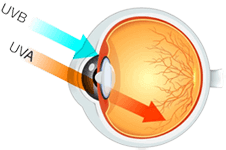 Did you know that 80% of our lifetime exposure to ultraviolet (UV) radiation occurs before the age of 18? Children receive 3 times the annual UV exposure than adults. The lens of the eye of a child under the age of 10 have not matured sufficiently to become effective filters of UV radiation and therefore allows more than 6 times the amount of UV radiation to penetrate more than an adult’s eye. Long-term exposure can result in cataracts, macular degeneration, corneal damage, pinguecula and pterygium growths and may increase the risk of eye melanoma.
Did you know that 80% of our lifetime exposure to ultraviolet (UV) radiation occurs before the age of 18? Children receive 3 times the annual UV exposure than adults. The lens of the eye of a child under the age of 10 have not matured sufficiently to become effective filters of UV radiation and therefore allows more than 6 times the amount of UV radiation to penetrate more than an adult’s eye. Long-term exposure can result in cataracts, macular degeneration, corneal damage, pinguecula and pterygium growths and may increase the risk of eye melanoma.
The most important source of this damage is exposure to UV radiation at a young age. UV exposure peaks when you are at high altitudes, snow-covered landscapes, bright sandy beaches, or near reflective bodies of water. Reflected UV light is just as damaging as direct UV. Water reflects up to 100%, snow reflects up to 85%, dry sand and concrete reflects up to 25%, and grass reflects up to 3% UV radiation. Sunglasses are as important for protecting your eyes as sunscreen is for protecting your skin. Sunglasses should be worn between 10 AM and 4 PM, when UV exposure is the most dangerous. Melanin in dark-coloured eyes acts as a protection pigment. Blue irises have less of this pigment and are therefore at greater risk.
UV rays can also cause damage in tanning booths and higher in certain occupations such as farmers, lifeguards, welders, and construction workers. Regardless of eye colour, location or occupation; it’s important for everyone to wear quality sunglasses year-round. When looking for sunglasses, make sure the labels say 100% UV protection against UVA and UVB, or 100% protection against UV 400, in order for the most protection. Talk to your optometrist about early detection of eye diseases and appropriate sun protection.
